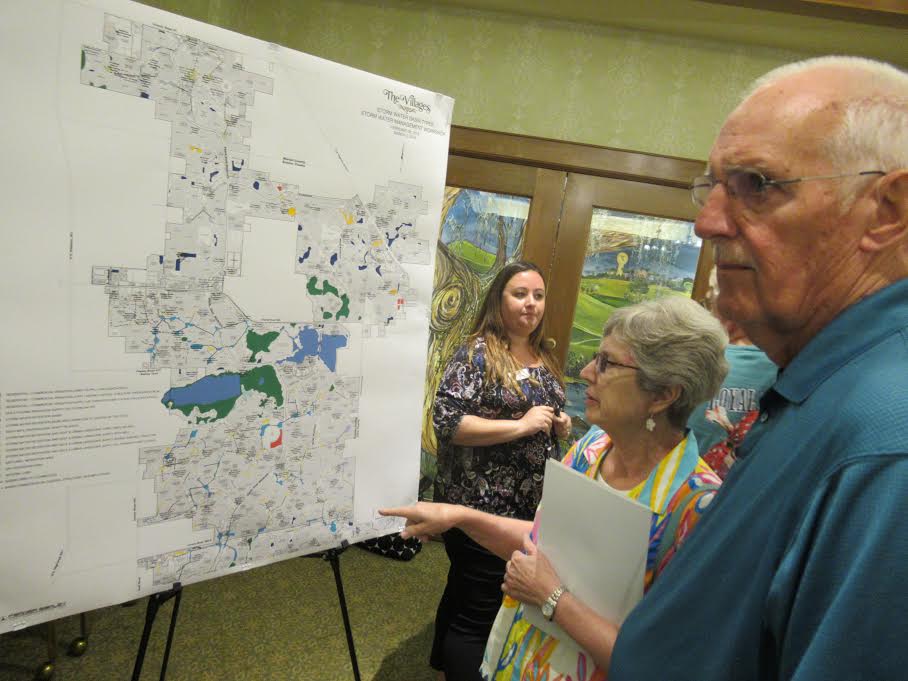Will there be another “once-in-a-lifetime” hurricane next year? Can torrential rains, during an uncommonly brutal rainy season, overwhelm The Villages’ storm water system and cause massive flooding?
No one knows. But one thing is certain, thanks to two Storm Water Management workshops. Villagers have a better understanding of the ramifications of major storms, and how The Villages lessen the impact of these “forces of nature.”
The first of two programs was conducted by The Villages Community Development Districts Monday afternoon at Rohan Recreation Center. An identical program is scheduled for March 2 at Savannah Center.
“Villagers should understand the importance of storm water,” said Richard Baier, assistant director of the Villages Community Development Districts. “Everyone needs to be good stewards of the environment. We hope that Villagers, as key components in our management of storm water, appreciate not only the aesthetics of our retention ponds but why their vital form and function are essential.”
He welcomed the capacity crowd of 384 residents, and introduced Trey Arnett, president of Arnett Engineering, who has been involved in the design and operation of the Villages’ water management system for 21 years.
“Storm water must be seen as an invaluable commodity. We use some 65 million gallons of water a day for fire suppression purposes and to meet our irrigation needs,” he said beginning his 45-minute presentation.
He explained how The Villages has a closed basin drainage model that does not rely on nearby rivers or lakes to drain away excess water. Therefore, The Villages needs adequate drainage and storage.
The area north of County Road 466 was built to meet the impact of a storm occurring once only every 10 years: a one-percent likelihood that a storm would dump 10 inches of rain in 24 hours. With a better appreciation of The Villages’ requirements, the storm management system built south of CR466 was designed to deal with a 25-year storm that drops seven inches of rain in 24 hours. The intent of golf courses in this area is to hold a high amount of water during these times.
Arnett went on to describe how The Villages’ administration closely monitored the track of Hurricane Irma as it moved northward – would it continue up its path along the west or east coasts or veer over the center part of the state?
“The hurricane followed a very wet summer so the ground was saturated,” he said. “We didn’t want to drain too much water, if the storm missed us. Water, as a resource, would have been hard to replace.
“The system worked incredibly well. There was no water in homes because they were built with floor elevations higher than the streets. There was no widespread flooding. Only some portions of a few streets had minor flooding when water backed up from the drains,” he said.
Arnett went on to explain how The Villages’ newer water irrigation system, south of CR 466, uses water based on a priority system: First is storm water; then reclaimed (waste) water; and finally ground water. He also described how minerals in the ground can cause “smelly” water; and also suggested that gardeners, interested in planting a vegetable garden, should use potable water coming from their home’s outdoor hose bibs.

He also answered a question on many people’s minds: why are golf course sprinklers often on during rain storms?
The reason: to reduce the water to an appropriate level of the nearby retention ponds.
His presentation was followed by a break-out session. Members of the District administration and Arnett Engineering staff, stationed at several large maps showing the Villages’ water management system, answered residents’ specific questions.
“The day’s program exceeded my expectations,” said District Manager Janet Tutt. “Both programs were sold out and the staff did an excellent job in presenting a basic overview to a very complex water management system.
“Also, the breakout session will allow us to better understand what is of interest to our residents,” she continued. “Their questions will help us prepare for future presentations.”
See more about the presentation at the link below:
Storm Water Management Workshop

